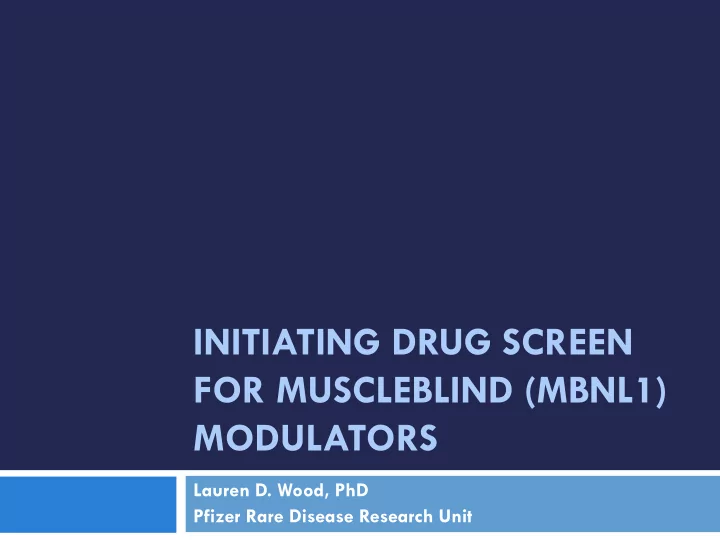

INITIATING DRUG SCREEN FOR MUSCLEBLIND (MBNL1) MODULATORS Lauren D. Wood, PhD Pfizer Rare Disease Research Unit
Disclaimer This presentation may include forward-looking statements. Actual results could differ materially from those projected in forward-looking statements. The factors that could cause actual results to differ are discussed in Pfizer Inc.’s Annual Report on Form 10K and in Pfizer Inc.’s reports on Form 10Q and Form 8-K. These reports are available on Pfizer Inc.’s website at www.pfizer.com in the “Investor-SEC Filings” Section. 2
Talk outline ¨ Overview of the drug discovery and development pipeline with an emphasis on early activities ¨ Pfizer’s approach to addressing CUG repeats pathology in DM ¤ Our choice for a high-throughput screening (HTS) assay ¤ Building and validating the HTS assay ¨ Initial screening results ¤ Confirmation of biological activity in patient-derived fibroblasts
Acknowledgements ¨ Fan Zhang ¨ Marigold Foundation ¨ Nicole Bodycombe ¨ Keith Haskell ¨ Lucy Sun ¨ Carl Morris ¨ Mat Pletcher ¨ Eric Wang-University of Florida ¨ Lyn Jones ¨ Jane Owens
Drug discovery and development process Early-‑stage ¡ Phase ¡2: ¡ Phase ¡3: ¡ FDA ¡ Preclinical ¡ Phase ¡1: ¡ research ¡& ¡ efficacy, ¡ efficacy, ¡ review ¡& ¡ studies ¡ safety ¡ discovery ¡ safety ¡ safety ¡ approval ¡ 1 2 3 4 High-‑ Develop ¡ Hit ¡ Target ¡ Lead ¡ Disease ¡selec)on ¡ throughput ¡ assay ¡ valida)on ¡ iden)fica)on ¡ op)miza)on ¡ screen ¡ 1. What is the disease aspect do you want to change (ie what do you want a chemical compound to do?) 2. Can you measure it? Is the assay fast? Is the assay reliable? Can assay be automated? 3. A chemical compound with a desired effect in an HTS screen is called a hit . Current status 4. Hits serve as starting points for target identification, pharmacology studies (what does it do in an animal model?), ADMET/PK (how does the body absorb, distribute, metabolize and excrete the compound? How long does it stay in the body? Can the hit be chemically modified to improve on these parameters?)
Pathogenic consequences of 35–~4,000 CUG repeats in DMPK RNA Pfizer’s approach: identify compounds that Small-molecule increase MBNL1 inhibitor approach Antisense oligonucleotide approaches Nature Reviews Drug Discovery 10, 621-637 (August 2011)
Establish a reporter gene system amenable to high throughput screening ¨ Chose immortalized HeLa cells as cell system since they are easy to grow/expand and express MBNL1 ¨ Marked the endogenous MBNL1 with a fluorescent tag ¤ Used latest technology to precisely insert tag into only the MBNL1 gene ¤ Very bright ZsGreen fluorescent tag ¨ Isolate ZsGreen-MBNL1 integrated cells ZsGreen-MBNL1 Parental line
“Automated” the system to detect changes in ZsGreen-MBNL1 levels ZsGreen A B HeLa -MBNL1 Identify 200 compounds that Seed cells in 150 multi -well Cell count increase that shift plate 100 this signal 37°C, 5% CO2, 24hr 50 Add 0 10 1 10 2 10 3 10 4 compound Green fluorescent intensity 37°C, 5% CO2, 48hr C Initial screen identified compounds that Trypsinize & demonstrated a dose-response in increasing Fix cells in 1% PFA ZsGreen-MBNL1 levels in the HeLa cell system 2.2 2.2 #22 #20 2.0 2.0 Read the MFI Fold Increase MFI Fold Increase 1.8 green 1.8 1.6 1.6 fluorescent 1.4 1.4 signal by Flow 1.2 1.2 Cytometer 1.0 1.0 0.8 0.8 0 1 2 3 4 5 6 0 1 2 3 4 5 6 µ M µ M
Compound #20 and #22 are histone deacetylases (HDAC) inhibitors ¨ HDAC inhibitors open chromatin to allow genes to be expressed ¨ Importantly, these hits in DM1 patient-derived cells: A. Increased endogenous MBNL1 levels B. Partially rescued the aberrant splicing ¨ These data help validate our screening system A B SERCA1a ADULT SERCA1b JUVENILE SERCA1 Human N DM1 fibroblasts DMSO DMSO #20 #22 300bp- SERCA1a ADULT 200bp- SERCA1b JUVENILE 150bp- 100bp-
Expansion of screen to larger chemical compound libraries ¨ Chemogenomic Library ¨ FDA Drug Set ¤ Well-defined, selective ¤ Marketed drugs and small molecules covering clinical stage compounds >1000 biological targets with known biological activity Compounds increase Compounds increase MBNL1 more than double Total MBNL1 > 3 × SD above the background Compound Screening Set Concentration Compound Number Hit Number (%) Hit Number Hit Rate (%) Hit Rate CGL 1 µ M 2753 128 4.6% 24 0.9% FDA Drug Set 10 µ M 1040 34 3.3% 10 1.0%
Grouping Chemogenomic Library hits into targeting gene families
Conclusions and future directions ¨ Conclusions: ¤ We established a robust cell-based screening system for MBNL1 up-regulators ¤ The initial screen identified HDAC inhibitors that increase MBNL1 level and partially rescue splicing ¤ Preliminary hits from expanded library screens suggest several novel therapeutic targets ¨ Future Directions: ¤ Validate and characterize compounds from Chemogenomics and FDA drug set screen ¤ In vivo testing selected compounds in DM1 mouse model
Recommend
More recommend